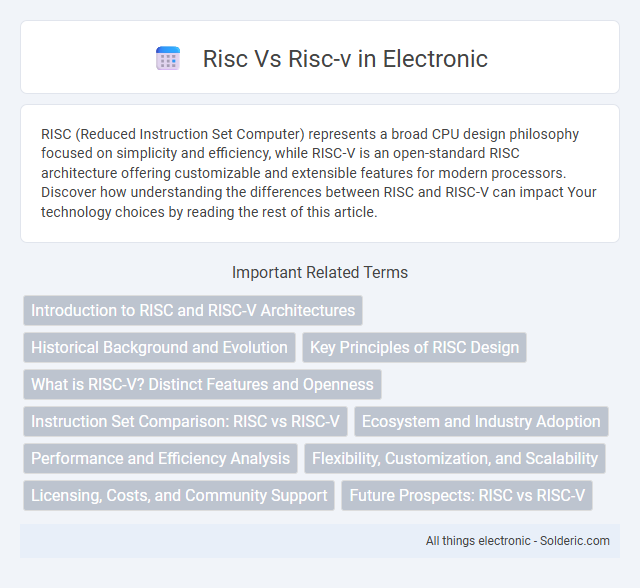RISC (Reduced Instruction Set Computer) represents a broad CPU design philosophy focused on simplicity and efficiency, while RISC-V is an open-standard RISC architecture offering customizable and extensible features for modern processors. Discover how understanding the differences between RISC and RISC-V can impact Your technology choices by reading the rest of this article.
Comparison Table
| Aspect | RISC | RISC-V |
|---|---|---|
| Definition | Reduced Instruction Set Computer architecture, a CPU design focused on simplified instructions for performance | An open-source RISC architecture offering a modular, extensible ISA developed at UC Berkeley |
| Instruction Set | Proprietary, varies by vendor | Open standard with base and optional extensions |
| Licensing | Usually proprietary, licensed by companies | Free and open-source under BSD license |
| Flexibility | Limited customization, fixed by vendors | Highly modular; customizable for specific applications |
| Community & Ecosystem | Established, vendor-driven ecosystems | Growing open-source community and industry support |
| Use Cases | Embedded systems, mobile CPUs, desktops | Embedded systems, IoT, AI accelerators, research |
| Example CPUs | ARM Cortex, MIPS | SiFive, Andes Technology |
Introduction to RISC and RISC-V Architectures
RISC (Reduced Instruction Set Computer) architecture emphasizes simplicity and efficiency through a limited set of instructions optimized for fast execution and low power consumption. RISC-V is an open standard ISA (Instruction Set Architecture) based on RISC principles, enabling customization, extensibility, and broad industry adoption without licensing fees. This modular and open-source design of RISC-V fosters innovation in processors for embedded systems, high-performance computing, and IoT devices.
Historical Background and Evolution
RISC (Reduced Instruction Set Computer) architecture emerged in the 1980s as a groundbreaking approach to simplify and speed up processor design by using a streamlined set of instructions, influencing the development of many modern CPUs. RISC-V, an open-source extension of the original RISC concept, was introduced in 2010 by researchers at UC Berkeley to offer a free, flexible instruction set architecture adaptable for diverse applications. Understanding the historical evolution of RISC and RISC-V can empower you to appreciate how open standards drive innovation in CPU design.
Key Principles of RISC Design
RISC (Reduced Instruction Set Computer) design emphasizes a small, highly optimized set of instructions that execute rapidly, enabling efficient pipeline use and simplified hardware. RISC-V extends these principles by offering an open-standard ISA (Instruction Set Architecture) that promotes modularity, extensibility, and openness, encouraging innovation and custom implementations across diverse applications. Your choice between traditional RISC and RISC-V impacts flexibility, ecosystem support, and long-term scalability in processor design.
What is RISC-V? Distinct Features and Openness
RISC-V is an open standard instruction set architecture (ISA) that extends the principles of Reduced Instruction Set Computing (RISC) with a modular and extensible design, allowing tailored customization for diverse applications. Unlike proprietary RISC ISAs, RISC-V's openness enables your hardware development to benefit from a freely accessible, community-driven ecosystem, fostering innovation and reducing licensing costs. Key distinct features include a clean-slate design, scalability from embedded to high-performance systems, and a rich set of standard and optional extensions that support customization without sacrificing interoperability.
Instruction Set Comparison: RISC vs RISC-V
RISC-V offers an open standard instruction set architecture (ISA) that contrasts with many proprietary RISC designs, providing greater flexibility and extensibility. Its modular instruction set allows customization for various applications, while traditional RISC ISAs often feature fixed, vendor-specific instructions. Understanding the differences in instruction sets helps optimize Your hardware design choices for scalability, compatibility, and innovation potential.
Ecosystem and Industry Adoption
RISC-V boasts a rapidly expanding open-source ecosystem with widespread support from leading tech companies, fostering innovation and customization beyond traditional RISC architectures. Industry adoption of RISC-V is accelerating in sectors like IoT, automotive, and edge computing due to its flexibility, cost-effectiveness, and community-driven development model. Your projects benefit from RISC-V's growing toolchains, software libraries, and broad hardware compatibility, ensuring future-proof scalability unmatched by proprietary RISC architectures.
Performance and Efficiency Analysis
RISC-V architecture offers enhanced performance and efficiency due to its open-standard design, enabling custom optimizations tailored to specific applications, unlike traditional proprietary RISC implementations. Its modular instruction set architecture (ISA) allows developers to implement only necessary extensions, resulting in lower power consumption and faster processing speeds for embedded and high-performance computing. Benchmark studies show RISC-V processors often achieve comparable or superior performance per watt compared to legacy RISC systems, driving innovation in energy-efficient computing solutions.
Flexibility, Customization, and Scalability
RISC-V offers unparalleled flexibility and customization compared to traditional RISC architectures, allowing developers to tailor instruction sets to specific application needs without licensing restrictions. Its open-source nature supports scalability across diverse platforms, from embedded systems to high-performance computing. You benefit from an evolving ecosystem that fosters innovation and optimized performance through modular design and extensible features.
Licensing, Costs, and Community Support
RISC-V offers an open standard instruction set architecture with permissive licensing, allowing free use, modification, and implementation without royalty fees, contrasting with proprietary RISC architectures that often require costly licenses. The open-source nature of RISC-V significantly reduces development and deployment costs for both academic institutions and commercial enterprises. A rapidly growing global community supports RISC-V through extensive collaboration, rich software ecosystems, and comprehensive documentation, whereas traditional RISC processors rely on vendor-driven support with limited community engagement.
Future Prospects: RISC vs RISC-V
RISC-V offers an open-source instruction set architecture (ISA) that fosters innovation, collaboration, and customization, positioning it as a leading choice for future embedded systems, IoT devices, and AI applications. RISC architectures, while established and widely adopted in commercial processors, face limitations in flexibility and cost compared to RISC-V's community-driven development model. Your investment in RISC-V technology can provide scalability, adaptability, and a growing ecosystem advantageous for emerging computing demands.
risc vs risc-v Infographic

 solderic.com
solderic.com